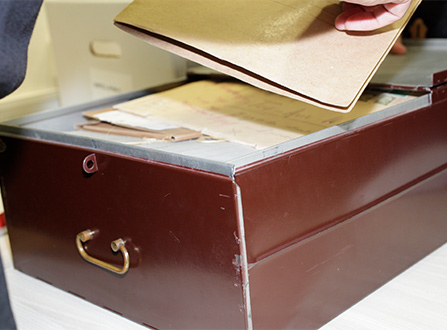The Archives Collection
Personal archives of outstanding personalities from a wide variety of spheres

Personal archives of outstanding personalities from a wide variety of spheres
In addition to its extensive collection of print materials, the National Library of Israel has, since its inception, developed a variety of other collections. Among these is the Archives Collection; indeed, for many years the Library was the only institution in the country that collected archives. The collection dates back to 1927, with the arrival of the first large archive – the rich personal archive of Ahad Ha'Am, which he bequeathed to the Library in his will.
Most of the archives have finding aids, though these records suffer from a lack of uniformity attributable to the fact that the archives arrived and were arranged at different times. A major project is currently underway to transfer the information contained in the physical records lists to the Library's computerized central catalogue. The Aleph cataloguing software program has been specially adapted to meet the needs of archival description, preserving hierarchy and context as per proper archival practice. The contents of archives that have been catalogued using Aleph can now be accessed through the Library's online catalogue and are readily available to readers in Israel and the world over.
The National Library of Israel thanks the Leir Foundation for its generous contribution to the recording and digitization of numerous historical archives from our collection. The foundation was established by Henry J. Leir (1900-1998) and Erna D. Leir (1902-1996).
This reading room is also known as the archive and manuscript room. Here one can view archival material, original manuscripts preserved in the library, microfilmed copies of manuscripts held elsewhere as well as rare printed books
Viewing Archival items requires authorization.
What is archival material?
According to the Archives Law (1955), archival material is "anything written on paper or any other medium or any sketch, diagram, map, drawing, musical notation, file, photograph, film, recording and the like (1) that are to be found in a state institution or a local authority, excluding material that is not original; (2) that are to be found anywhere and that can be used for researching the past, the nation, the state or society or that are related to the memory or activities of well-known people."
What is an archive?
An archive is a collection of archival material that has been created as a result of the activities of a person or an organization. An archive is also the repository where archives are stored, for example, the State Archives.
What is a personal archive?
A personal archive (bequest) consists of archival material that has been created as a result of a person's activities during their lifetime, for instance, personal documents, correspondence, manuscripts, photographs and digital material. Sometimes the personal archive may contain collections that that person has assembled.
What constitutes an archival collection?
An archival collection comprises a group of archival documents, photographs, newspaper cuttings or any other archival material that was specially brought together by an institution or an individual. Unlike in an archive, the connection between the collection's items is based on a common subject. Sometimes the collection is part of a personal or institutional archive, when it is assembled within the framework of the activities of that person or institution.
If a small section of a personal or institutional archive is kept in an institution other than that which houses the main body of the archive, it is also called a "collection".
What is the difference between an archive and a collection?
Unlike a personal archive or a bequest, a collection is created by a third party. Typically, collections are devoted to a particular subject that can be a part of a particular individual's activities. Contents of personal collections dedicated to individuals can include: letters, articles written by or about that person, newspaper clippings, photos and more. Other collections may be focused on other issues such as: photos, autographs and more